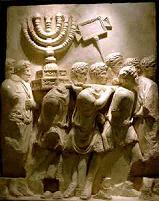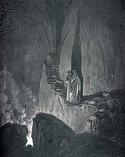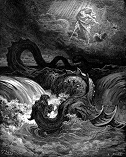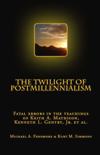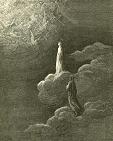Why I Reject Old Earth Creationism and
The Regional Flood
By Kurt Simmons
Introduction
There
are afoot today doctrines that no one in the history of Christianity
or Judaism heard of until recent years.
They are modernistic not only because they only recently
appeared, but because they take a low view of inspiration and the
Bible, and freely reject the written word in favor of their own
enlightened and exalted judgment.
I refer to “old earth creationism” and the theory of a
“regional flood.”
Having studied the claims and methodology of these theories, I
reject them as Biblically insupportable.
Some of my reasons are as follows.
I.
The Theories of a Regional Flood and Old
Earth Violate Basic Principles of Biblical Hermeneutics
The
first and most fundamental objection to the regional flood and
related theories of “day/age” and “gap,” which belong to the theory
of “old earth creationism,” is that they violate basic principles of
hermeneutics.
Hermeneutics is the science of establishing principles and precepts
by which writings are interpreted.
The first rule of hermeneutics is that a writing is to be
interpreted according to the intent of the author.
When approaching a document or writing, we thus ask “what did
the author intend the reader to understand?”
It is not what interpretation a writing will bear, or how
cleverly we can argue for hidden or double meanings, or ingeniously
construct allegories from a text.
But what did the author intend?
If the author did not intend a particular meaning to be
communicated by a writing, then that meaning is to be rejected as
not in the text. No
matter how persuasively we argue for its existence, if the author
did not intend it to be understood that way, it is not in the text.
Another principle of hermeneutics is that a
writing is to be understood literally unless the context requires
otherwise. It is not
enough that the phraseology may be interpreted figuratively; all
language may be interpreted figuratively.
Before we depart from the normal meaning attached to words
the author must intend and the context must require it be
figuratively understood.
In poetry, prophecy, and apocalyptics the opposite rule
obtains. In dealing
with those forms of literature we assume that the language is
figurative unless the context demands otherwise.
This assumption is based upon the intention of the author.
The author intends we understand him to be using language
hyperbolically. A
related principle of hermeneutics that helps us identify the
author’s intent is to first identify the category to which the
writing belongs. The
class of literature we are dealing with can tell us much about how
the author intended it be understood. Are we dealing with poetry and
prophecy, or historical narrative?
Poetry and prophecy typically are not intended to be
interpreted literally, but historical narrative almost invariably
is. History that is not
literal is not history; it is fiction, myth, or allegory.
Prophetic books of the Bible often draw upon historical
events for their imagery, but that does not mean that historical
books are to be understood figuratively or interpreted in the same
manner as books of prophecy. Revelation employs imagery drawn from
Genesis, but that does not mean Genesis is of the same genre of
literature as Revelation or that we interpret them according to
similar principles.
John intended Revelation’s imagery to be interpreted figuratively.
Virtually all commentators admit this fact.
But there is no evidence Moses possessed the like intent in
Genesis.
The purpose of Genesis is to provide mankind
with an explanation of the origin of life and all that exists; to
show man that he is the product of God’s special creation and the
object of God’s inestimable love; to explain the fall of the race
and the entrance of sin and death; and, finally, to hold out to
mankind God’s promise of redemption in Jesus Christ.
The history of redemption is interwoven with the history of
men and nations. Hence,
Genesis also introduces us to the various races and languages of
people that sprang from the sons of Noah after the flood.
We are introduced to Abraham and God’s promises him,
particularly as these involved the children of
Given the purpose of Genesis, the idea that
there is concealed within the creation account a “gap” consisting of
millions of years, which elapsed between God’s creation of the
heavens and earth and the evening and the morning of the first day,
must be rejected.
An objective reading will show that no gap is stated or implied.
The whole notion is something that advocates of the view have
invented and imposed upon the text; the text may bear this
imposition (silence will bear many such impositions), but it cannot
in fairness be said that Moses intended the reader to understand a
gap existed in God’s creation of the cosmos.
Certainly, no Biblical writer ever mentions a gap or suggests
in any way that such occurred or exists.
One can search thousands of years of Jewish and Christian
history and will find no suggestion anywhere of a gap.
The day/age theory suffers the same defect.
If God intended readers to understand that the six “evenings
and mornings” of creation were something other than twenty-four hour
days, then he chose a very inconvenient way of communicating that
fact.
“For in six days the Lord God created the heavens, the earth,
the sea, and all that in them is.”
(Ex. 20:11)
There is no “wiggle” room in this statement.
It is a straight-forward affirmation that the cosmos and
everything therein was created in the space of days (“six evenings
and mornings.”) Other
occurrences of the phrase “evening and morning” are equally literal
and point to the space of a single twenty-four hour day.
The Psalmist employs the phrase “evening, morning, and at
noon” to show his daily worship of the Lord (Ps. 55:17) and Daniel
uses the space of twenty-three hundred “evenings and mornings” to
signify the six and half year space Antiochus Epiphanes would
oppress the people of God and defile the temple.
(Dan. 8:14, 26)
New Testament writers also understood the days
of creation literally.
John draws upon the creation account in his gospel by opening with
the same three words Moses used (“in the beginning”), and identifies
seven literal days in Jesus’ early ministry for the purpose of
suggesting that Christ is the spiritual recreation.
(Jno. 1:29, 35, 43; 2:1; cf. II Cor. 4:6)
If the “evenings and mornings” of Genesis represent millions
of years, John certainly was misled to understand them literally.
Paul too was misled, for his whole theology of two
Because the theories of old earth creationism
and a regional flood are no part of the original intent of Genesis,
and find no endorsement by any Biblical writer, they must be
rejected as spurious innovations that lack serious scholarship.
Former regius professor of Hebrew at
"Probably, so far as l know, there is no professor of Hebrew
or Old Testament at any world-class university who does not believe
that the writer(s) of Gen. 1-11 intended to convey to their readers
the ideas that (a) creation took place in a series of six days which
were the same as the days of 24 hours we now experience (b) the
figures contained in the Genesis genealogies provided by simple
addition a chronology from the beginning of the world up to later
stages in the biblical story (c) Noah's flood was understood to be
world-wide and extinguish all human and animal life except for those
in the ark. Or, to put it negatively, the apologetic arguments which
suppose the 'days' of creation to be long eras of time, the figures
of years not to be chronological, and the flood to be a merely local
Mesopotamian flood, are not taken seriously by any such professors,
as far as I know."
II.
The Theories Old Earth Creationism and Regional Flood are Apologetic
Attempts to Reconcile the Bible with Errors of Modern Science
The next reason I reject the regional flood and
related theories is that they are nothing but attempts to bend the
Bible to accord with the errors of modern science. They are modern
inventions virtually unknown until little more than an hundred years
ago. Their appearance
in recent times does not represent a “return to the Bible,” but a
departure there from; a capitulation to errors of the theoretical
sciences, not a stand upon the word of God.
If these theories represented a return to the Bible, we would
expect to find at least some evidence that these opinions were
espoused in earlier times by Jews or Christians.
However, not a single ancient writer can be produced who
speaks of the earth being millions of years old or that the flood
was merely regional. A
survey of ancient sources will make the point.
Among the Jews, Josephus may be taken as
representative.
Josephus plainly held to six literal days of creation:
Accordingly Moses says that in just six days the world and
all that is therein was made; and that the seventh day was a rest,
and a release from the labour of such operations; whence it is that
we celebrate a rest from our labours on that day, and call it the
Sabbath; which word denotes rest in the Hebrew tongue.
Notice that Josephus here cites Ex. 20:11
almost verbatim for the proposition that all creation was completed
in the space of just six days.
The church fathers also unanimously agree that the days of
creation were literal.
Space does not permit us to do more than list some representative
passages demonstrating the patristic writers’ belief in the literal
days of creation.
(Justine Martyr, Hortatory Address to the Greeks, Ante-Nicene
Fathers, Vol. I, p. 287; Irenaeus Against the Heresies, Bk. 5,
Ante-Nicene Fathers, Vol. I, p. 557;
Theophilus to Autolycus, Ante-Nicene Fathers, Vol. II, Bk.
II, pp. 99-120; Clement of Alexandria, The Stomata, Ante-Nicene
Fathers, Vol. II, pp.438, 512-513 ; Tertullian, A Treatise on the
Soul, Ante-Nicene Fathers, Vol. III , p. 218; Origen, Against
Celsus, Ante-Nicene Fathers Vol. IV, p. 404, 600-601; The Extant
Works and Fragments of Hippolytus, Ante-Nicene Fathers Vol. V, p.
163; Julius Africanus, Ante-Nicene Fathers Vol. VI, pp. 130-131;
Peter, Bishop of Alexandria, Ante-Nicene Fathers Vol. VI, p. 283;
Methodius, Discourse VII –Procilla, Ante-Nicene Fathers Vol. VI, p.
333; Discourse IX - Tusiane, Ante-Nicene Fathers Vol. VI, p. 344;
Lactantius, Bk. VII, Ante-Nicene Fathers Vol. VII, p. 211;
Victorinus, On the Creation of the World, Ante-Nicene Fathers, Vol.
VII, p. 341)
Concerning Noah’s flood, early Jewish sources
are unanimous that the flood was universal.
The non-canonical book of I Enoch was written during the
intertestamental period.
It is not inspired, but it does give us a view into the
understanding of the Jews in the second century before Christ:
Then said the Most High, the Holy and Great One spake, and
sent Uriel to the son of Lamech, and said to him: 'Go to Noah and
tell him in my name "Hide thyself!" and reveal to him the end that
is approaching: that the whole earth will be destroyed, and a deluge
is about to come upon the whole earth, and will destroy all that is
on it. And now instruct him that he may escape and his seed may be
preserved for all the generations of the world.
Josephus also unambiguously affirms the
universal flood:
Now God loved this man for his righteousness; yet he not only
condemned those other men for their wickedness, but determined to
destroy the whole race of mankind, and to make another race…he
turned the dry land into sea; and thus were all these men destroyed:
but Noah alone was saved.
Advocates of the regional flood theory argue
for a narrow reading of the term rendered “earth” in the flood
account (erets), but not a single translation in existence supports
them. Josephus, a
priest who could think and speak in Hebrew, is also decidedly
against them; he defines the “earth” by the phrase “dry land,” the
very term used in Genesis to distinguish the earth from the sea.
(Gen. 1:9) Thus,
Josephus is saying that the creation was reversed, all the dry land
submerged, and chaos resumed, so that a new creation could be made
in which Noah would provide the seed.
The church fathers also weigh in on the side of
the universal flood:
Theophilus
An Accurate Account of the Deluge:
And this Noah had three sons (as we mentioned
in the second book), whose names were Shem, and Ham, and Japhet; and
these had three wives, one wife each; each man and his wife. This
man some have surnamed Eunuchus. All the eight persons, therefore,
who were found in the ark were preserved. And Moses showed that the
flood lasted forty days and forty nights, torrents pouring from
heaven, and from the fountains of the deep breaking up, so that the
water overtopped every high hill 15 cubits. And thus the race of all
the men that then were was destroyed, and those only who were
protected in the ark were saved; and these, we have already said,
were eight. And of the ark, the remains are to this day to be seen
in the Arabian mountains. This, then, is in sum the history of the
deluge Theophilus, To Autolycus, Bk. III, chap xix, Ante-Nicene
Fathers, Vol. II, .pp. 116-117
Clement of
The Recognitions of Clement,
Bk. I
God brought a flood upon the world that the
earth might be purified from their pollution, and every place might
be turned into a sea by the destruction of the wicked. Yet there was
then found one righteous man, by name Noah, who, being delivered in
an ark with his three sons and their wives, became the colonizer of
the world after the subsiding of the waters, with those animals and
seeds which he had shut up with him.
Hippolytus, Refutation of All Heresies,
Bk. X, Chapter XXVI.
Jewish Chronology
And in Noah's time there occurred a flood
throughout the entire world, which neither Egyptians, nor Chaldeans,
nor Greeks recollect; for the inundations which took place in the
age of Ogyges and Deucalion prevailed only in the localities where
these dwelt.
The sum of this testimony is that all of the
dry ground was submerged beneath the waters of the flood; the waters
going over the tops of the mountains by fifteen cubits, Noah and his
family of all earth’s people alone being saved.
Thus, the voice from antiquity is unanimous in affirming the
traditional belief about creation and the flood.
Not a single source can be produced on the side of regional
flood advocates or old earth creationists.
There is a good reason why the ancients believed in the
literal six days of creation and universal flood:
No one reading Genesis could conclude otherwise!
The incentive – the only incentive - to depart from the plain
language of the text finds its source in modern science and men’s
attempts to reconcile the Bible to its claims.
It is a case of extra-biblical beliefs and theories driving
one’s interpretation of the Bible, rather than allowing the
scripture to speak for itself.
The ancients lacked the impetus to reconcile the Bible to
modern science and therefore affirmed the traditional accounts of
the flood and creation, relying upon the Bible as the unsullied word
of God.
Modern man, educated in government schools and
assaulted on every side by assertions that the earth is billions of
years old, feels pressure to make an apology for the Bible; he feels
he must “square” the Bible with scientific claims.
Such are old earth creationists and regional flood advocates.
These men overlook, however, the fact that claims concerning
the age of the earth and origin of life do not originate in true
empirical science, but the theoretical sciences; branches of science
which have no hard evidence for their claims, but build theories
upon unproven premises and extrapolations which can never be
scientifically shown or demonstrated.
Old earth creationists and regional flood advocates thus
jettison the Bible in favor of the unproven theories of men.
A poor trade off if ever there was one.
But if extra-biblical beliefs determine how one interprets
the Bible, what is this but to say his beliefs are in fact
unbiblical? And so it
is that the theories of old earth creationism and a regional flood
can never be biblical, since they find their source and impetus
outside the Bible.
III. The New Testament Confirms the Cosmos
was Destroyed
If there were a question about the literalness
of the Old Testament narrative or the definition of the words or
phrases employed, the New Testament obviates the discussion by twice
affirming that the cosmos was destroyed.
Heb. 11:7 – By faith Noah, being warned of God of things not
seen as yet, moved with fear, prepared an ark to the saving of his
house; by the which he condemned the world (Grk. kosmos), and became
heir of the righteousness which is by faith.
II Pet.
2:5 – And spared not the old world (kosmos), but saved Noah the
eighth person, a preacher of righteousness, bringing in the flood
upon the world (kosmos) of the ungodly.
In both of these verses the term used to
describe the object destroyed by the flood is the Greek word
“kosmos.” Cosmos is the
opposite of chaos.
Kosmos is defined as an orderly arrangement, viz., the universe, the
world, and/or the inhabitants of the world.
It is distinguished from 1) aion, an age, 2) ge, earth or
land, and 3) oikoumene, the inhabited earth, viz., world or
IV. Proponents of the Regional Flood Are
Guilty of Insupportable Claims
and Irresponsible Exegesis
Old
earth creationism and the theory of a regional flood suffer more
than bad hermeneutics in their basic suppositions and methodology;
they also make many insupportable claims and engage in irresponsible
exegesis. Here are a
few couple examples of the sort of unsound assertions coming out of
this corner.
Assertion
that Belief in a Universal Flood Stems from Modern Language,
Science, and Dispensationalism
One writer has made assertions that belief in a
universal flood is a modern phenomenon; that ancient peoples
believed Noah’s flood was merely local.
This assertion is, of course, completely unfounded; not a
single ancient writer can be produced that affirms belief in a
regional flood. The
writer alleges first that belief in a universal flood is owing to
modern English:
The question we deal with has always been whether it is
proper to read Genesis 6-9 according to a plain-literal approach in
regard to the global language as it reads in modern English.
The writer then alleges that belief in a
universal flood is the result of modern scientific notions:
The “global flood interpretation is a result of modern
Western scientific definitions of the language that are demonstrably
foreign to the original authors and audience of the texts.”
The writer then asserts that belief in a
universal flood grows out of modern Dispensationalism:
The global flood idea is essentially a dispensational
futurist concept born out of the naïve method of literalism.
There is not a single one of the above
assertions that has any substance.
In fact, they could not be more incorrect.
As we have already seen, the unanimous voice of antiquity
affirms the universal flood.
If anything, it is the idea of a regional flood and old earth
creationism that are modern and find their impetus in the errors of
modern theoretical sciences.
So far as we know, not a single ancient author affirms a
regional flood as advocated by the above writer.
Assertion that Noah’s flood consisted of
only 20 Feet of Water
And the waters prevailed, and were increased greatly upon the
earth; and the ark went upon the face of the waters.
And the waters prevailed exceedingly upon the earth; and all
the high hills, that were under the whole heaven, were covered.
Fifteen cubits upward did the waters prevail; and the
mountains were covered.
And all flesh died that moved upon the earth, both of fowl, and of
cattle, and of beast, and of every creeping thing that creepeth upon
the earth, and every man: All in whose nostrils was the breath of
life, of all that was in the dry land, died. Gen. 7:18-22
In an attempt to avoid the implication of the
Genesis language above, that the flood waters covered the high hills
under heaven to the depth of fifteen cubits, advocates of the
regional flood theory suggest that the waters were merely fifteen
cubits altogether and did not cover the mountains at all.
Of course, there is not a single translation in existence
that supports them, but then that has never been a deterrent to
their willingness to rewrite the word of God.
For argument’s sake, let it be granted that the Hebrew is
susceptible of this construction (it’s not), let us test their
theory. The scripture
says the ark was three hundred cubits long, fifty cubits wide, and
thirty cubits high. A
cubit is approximately seventeen inches.
That means the ark was roughly 425’ x 70’ x 42’.
Obvisouly, it is impossible for an ark 425’ long, made of
timbers, to be floated in waters only fifteen cubits (20 ft.) deep.
Thus, proponents of the regional flood theory are proven
wrong again.
Their irresponsible treatment of the scripture only serves to
demonstrate their error.
V.
Old Earth Creationism and a Regional Flood Contradict Important
Doctrines of Scripture
As we have seen, not a single sacred writer or
ancient author, Jewish or Christian, can be produced that lends
credence to the notions of old earth creationism or a regional
flood. All are agreed
that creation occurred in the space of six literal days and that the
flood was universal in scope.
Moreover, we have seen that it is only by violence to the
most basic principals of hermeneutics that a case for old earth
creationism and a regional flood can be made, and that the sole
incentive for imposing these errors on the divine text is to
reconcile the declarations of the sacred page with the errors of
profane science. These
are more than sufficient in themselves to require rejection of these
theories. But there are
more. Another reason to
reject them is their direct contradiction of important doctrines of
scripture.
The Doctrine of Two
Perhaps the single most important doctrine in
the Bible is the doctrine of “two
For if by one man’s offence death reigned by one; much more
they which receive abundance of grace and of the gift of
righteousness shall reign in life by one, Jesus Christ…For as by one
man’s disobedience many were made sinners, so by the obedience of
one shall many be made righteous.
Rom.
Paul’s language is interpreted differently by
different denominational groups within Christendom.
Catholic, Lutheran, Presbyterian, Anglican/Episcopal, and
Reformed churches interpret Paul’s language in terms of God’s
imputing Adam’s legal guilt and accountability to his descendants,
thus requiring even infants to be saved (this is the origin of
infant baptism). Other
churches interpret the language in terms of Adam’s descendants
inheriting only the physiological consequences of his transgression,
causing them to be at enmity with the things of the Spirit by
nature, incapable of living above their carnal appetites.
Those holding to this view believe that accountability for
sin is personal and attaches only when a child reaches sufficient
maturity to understand the nature of his acts and to know that they
are wrong. These groups
therefore baptize only adults.
Despite differences in interpretation, all acknowledge the
doctrine of the inherited or imputed nature of Adam’s transgression
and consider it an essential tenant of the faith.
Old earth creationists and regional flood
advocates, holding that the creation account is a mere fiction or
allegory, a symbolic representation, not an actual historical
account, must logically deny the doctrine of two
Perhaps we should ask what authority advocates
of old earth creationism and a regional flood offer in support of
their assertions God created other men than Adam and that others
survived the flood than Noah?
The answer: none whatever!
Not a single verse of scripture can be marshaled to sustain
their views. The
theories rest on no other foundation than bare assertion, empty
supposition, and appeal to the errors of modern science.
Moreover, not only do their assertions have no scriptural
basis, they contradict both divine and secular historical accounts
of human life and civilization.
It is an interesting and highly significant
fact that all recorded history agrees with the sacred page.
Unlike the discrepancy between scripture and the errors of
modern, atheistic science, there are not two historical worlds: the
Biblical world and the “true” world of secular history.
All historical accounts, including archaeological
investigation and discovery of the growth and spread of the human
race, corroborate the Genesis and Biblical accounts perfectly.
Unlike the theoretical “sciences” of origins and dating the
earth, in history we deal with facts, and these accord with the
Bible. Man is first
found in the areas of ancient
This creates an insurmountable hurdle for
advocates of old earth creationism and a regional flood.
If God created other races of men than those who trace their
descent from Adam and if more survived the flood than Noah, then we
would expect that the world to have infinitely more people than it
presently does and the history of the growth and spread of the race
would vary from that set out in the Bible, much as the theoretical
science of origins varies from the Genesis account of creation.
With each additional man and woman God is alleged to have
created, the race would have multiplied proportionately faster.
If God created only one other race than Adam, man would have
multiplied twice as fast; if two others, thrice as fast, and so
forth. However, the
picture that emerges from secular history mirrors that of the Bible,
showing that mankind has grown from its single, original source in
Adam and Noah.
Typological Teaching of the Universal
Flood
If old
earth creationists destroy the typological doctrine of two Adams and
man’s inherent need of the Savior, regional flood advocates destroy
the typological importance of the universal flood and man’s need for
salvation only through Jesus Christ.
Peter employed the flood and ark as type of baptism and the
church to show that only those who obeyed the message to repent and
be baptized would be saved:
The longsuffering of God waited in the days of Noah, while
the ark was a preparing, wherein eight souls were saved by water.
The like figure whereunto even baptism doth also now save us
(not the putting away of the filth of the flesh, but the answer of a
good conscience toward God,) by the resurrection of Jesus Christ.
I Pet. 3:20, 21
Peter’s argument may be succinctly stated thus:
as Noah was saved by obeying the message to prepare the ark, so men
are saved today by obedience to the commandment to repent and be
baptized, by which they get out of sin and into Christ.
But if men other than Noah came safely through the flood,
then it follows that men will be saved out of Christ, which the ark
typifies, and Peter’s whole analogy is worthless.
Again we see the destructive nature of the novel theory of a
regional flood and how it strikes at essential tenants of the
Christian faith.
Conclusion
Old earth creationism and the notion of a
regional flood are apologetic attempts to reconcile the Bible with
the errors of modern, theoretical science; they are founded upon bad
hermeneutics and contradict numerous plain statements of scripture.
Discerning students of scripture will reject these specious
theories.
Notes:
“Evenings and mornings” is used because there
is no more effective way to communicate a twenty-four hour period.
Sun-rise to sunrise has the inconvenience of causing one day
to end at the very time men are beginning the labor of the next, and
mid-night to mid-night cannot be measured without mechanical
assistance. Hence, the
space between two evenings is the easiest way to mark the
twenty-four hour period making up the period of human activity
during the daylight.
Moreover, since evening also marks the time men rest, it was
especially useful in marking the beginning of the Sabbath, since
this began at even.
The whole letter is posted at
http://www.geocities.com/ilgwamh/day.html
A possible exception might be writers from
among the Greeks who brought spurious pagan notions about the
eternality of the universe with them into the church.
Josephus, Antiquities, I, i, 1; Whiston ed.
I
Enoch, Chapter 10; emphasis added.
Ibid, I, iii, 2; Whiston ed.
We avoid the term global because the Bible does not use the term; it
says only that all the dry ground was covered, without saying how
much dry ground (viz., how many continents) existed at the time.
“India is the farthest part of the inhabited
world toward the east…Arabia is the farthest of the inhabited
countries toward the south…where the meridian declines toward the
setting sun, the Ethiopian territory reaches, being the extreme part
of the habitable world.”
Herodotus, III, cxvi-xiv.
To receive Kurt Simmons’ e-mail newsletter, The Sword & The Plow, click the Subscribe link:
All rights reserved.
